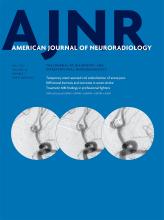Index by author
Nagel, S.
- INTERVENTIONALYou have accessCorrelation of Thrombectomy Maneuver Count with Recanalization Success and Clinical Outcome in Patients with Ischemic StrokeF. Seker, J. Pfaff, M. Wolf, P.A. Ringleb, S. Nagel, S. Schönenberger, C. Herweh, M.A. Möhlenbruch, M. Bendszus and M. PhamAmerican Journal of Neuroradiology July 2017, 38 (7) 1368-1371; DOI: https://doi.org/10.3174/ajnr.A5212
Naggara, O.
- FELLOWS' JOURNAL CLUBEXTRACRANIAL VASCULARYou have accessTIPIC Syndrome: Beyond the Myth of Carotidynia, a New Distinct Unclassified EntityA. Lecler, M. Obadia, J. Savatovsky, H. Picard, F. Charbonneau, N. Menjot de Champfleur, O. Naggara, B. Carsin, M. Amor-Sahli, J.P. Cottier, J. Bensoussan, E. Auffray-Calvier, A. Varoquaux, S. De Gaalon, C. Calazel, N. Nasr, G. Volle, D.C. Jianu, O. Gout, F. Bonneville and J.C. SadikAmerican Journal of Neuroradiology July 2017, 38 (7) 1391-1398; DOI: https://doi.org/10.3174/ajnr.A5214
This study included 47 patients from 10 centers presenting between January 2009 through April 2016with acute neck pain or tenderness and at least 1 cervical image showing unclassified carotid abnormalities. The authors conducted a systematic, retrospective study of their medical charts and diagnostic and follow-up imaging. All patients presented with acute neck pain, and 8 presented with transient neurologic symptoms. Imaging showed an eccentric pericarotidian infiltration in all patients. An intimal soft plaque was noted in 16 patients, and a mild luminal narrowing was noted in 16 patients. The authors conclude that this study improves the description of an unclassified, clinico-radiologic entity, which could be described by the proposed acronym: Transient Perivascular Inflammation of the Carotid artery (TIPIC) syndrome.
Naik, S.
- ADULT BRAINYou have accessPontomesencephalic Atrophy and Postural Instability in Wilson DiseaseJ. Kalita, S. Naik, S.K. Bhoi, U.K Misra, A. Ranjan and S. KumarAmerican Journal of Neuroradiology July 2017, 38 (7) 1343-1347; DOI: https://doi.org/10.3174/ajnr.A5207
Narayanan, S.
- HEAD & NECKYou have accessSolid Lymph Nodes as an Imaging Biomarker for Risk Stratification in Human Papillomavirus–Related Oropharyngeal Squamous Cell CarcinomaT.J. Rath, S. Narayanan, M.A. Hughes, R.L. Ferris, S.I. Chiosea and B.F. BranstetterAmerican Journal of Neuroradiology July 2017, 38 (7) 1405-1410; DOI: https://doi.org/10.3174/ajnr.A5177
Nasr, N.
- FELLOWS' JOURNAL CLUBEXTRACRANIAL VASCULARYou have accessTIPIC Syndrome: Beyond the Myth of Carotidynia, a New Distinct Unclassified EntityA. Lecler, M. Obadia, J. Savatovsky, H. Picard, F. Charbonneau, N. Menjot de Champfleur, O. Naggara, B. Carsin, M. Amor-Sahli, J.P. Cottier, J. Bensoussan, E. Auffray-Calvier, A. Varoquaux, S. De Gaalon, C. Calazel, N. Nasr, G. Volle, D.C. Jianu, O. Gout, F. Bonneville and J.C. SadikAmerican Journal of Neuroradiology July 2017, 38 (7) 1391-1398; DOI: https://doi.org/10.3174/ajnr.A5214
This study included 47 patients from 10 centers presenting between January 2009 through April 2016with acute neck pain or tenderness and at least 1 cervical image showing unclassified carotid abnormalities. The authors conducted a systematic, retrospective study of their medical charts and diagnostic and follow-up imaging. All patients presented with acute neck pain, and 8 presented with transient neurologic symptoms. Imaging showed an eccentric pericarotidian infiltration in all patients. An intimal soft plaque was noted in 16 patients, and a mild luminal narrowing was noted in 16 patients. The authors conclude that this study improves the description of an unclassified, clinico-radiologic entity, which could be described by the proposed acronym: Transient Perivascular Inflammation of the Carotid artery (TIPIC) syndrome.
Neff, F.
- INTERVENTIONALYou have accessImpact of Anesthesia on the Outcome of Acute Ischemic Stroke after Endovascular Treatment with the Solitaire Stent RetrieverA. Slezak, R. Kurmann, L. Oppliger, A. Broeg-Morvay, J. Gralla, G. Schroth, H.P. Mattle, M. Arnold, U. Fischer, S. Jung, R. Greif, F. Neff, P. Mordasini and M.-L. MonoAmerican Journal of Neuroradiology July 2017, 38 (7) 1362-1367; DOI: https://doi.org/10.3174/ajnr.A5183
Netto, J.P.
- PATIENT SAFETYOpen AccessWhat Does the Boxed Warning Tell Us? Safe Practice of Using Ferumoxytol as an MRI Contrast AgentC.G. Varallyay, G.B. Toth, R. Fu, J.P. Netto, J. Firkins, P. Ambady and E.A. NeuweltAmerican Journal of Neuroradiology July 2017, 38 (7) 1297-1302; DOI: https://doi.org/10.3174/ajnr.A5188
Neuwelt, E.A.
- PATIENT SAFETYOpen AccessWhat Does the Boxed Warning Tell Us? Safe Practice of Using Ferumoxytol as an MRI Contrast AgentC.G. Varallyay, G.B. Toth, R. Fu, J.P. Netto, J. Firkins, P. Ambady and E.A. NeuweltAmerican Journal of Neuroradiology July 2017, 38 (7) 1297-1302; DOI: https://doi.org/10.3174/ajnr.A5188
Nicola, G.N.
- You have accessThe Qualified Clinical Data Registry: A Pathway to Success within MACRAM.M. Chen, A.B. Rosenkrantz, G.N. Nicola, E. Silva, G. McGinty, L. Manchikanti and J.A. HirschAmerican Journal of Neuroradiology July 2017, 38 (7) 1292-1296; DOI: https://doi.org/10.3174/ajnr.A5220
Nietert, P.J.
- EDITOR'S CHOICEADULT BRAINOpen AccessDiffusional Kurtosis Imaging and Motor Outcome in Acute Ischemic StrokeM.V. Spampinato, C. Chan, J.H. Jensen, J.A. Helpern, L. Bonilha, S.A. Kautz, P.J. Nietert and W. FengAmerican Journal of Neuroradiology July 2017, 38 (7) 1328-1334; DOI: https://doi.org/10.3174/ajnr.A5180
The authors evaluated 17 patients with stroke who underwent brain diffusional kurtosis imaging within 4 days after the onset of symptoms. Neurologic evaluation included the Fugl-Meyer Upper Extremity Motor scale in the acute phase and 3 months poststroke. The largest percentage signal changes of the lesioned hemisphere corticospinal tract were observed with axial kurtosis, with an average 12% increase compared with the contralateral corticospinal tract. The strongest associations between the 3-month Fugl-Meyer Upper Extremity Motor scale score and diffusion metrics were found for the lesioned/contralateral hemisphere corticospinal tract mean kurtosis and axial kurtosis ratios. They conclude that diffusion metrics related to kurtosis were found to be more sensitive than conventional diffusivity metrics to early poststroke corticospinal tract microstructural changes.








